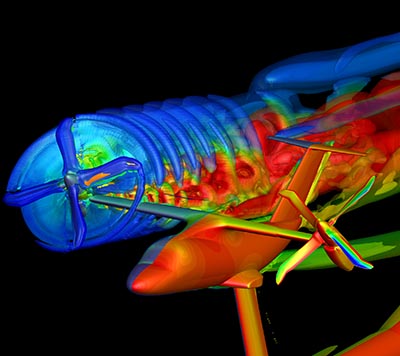RAL - Rotorcraft Aerodynamic Lab
Contact Person
Prof. Giuseppe Gibertini
Phone Number
+39 02 2399 8389
Mail Address
Ongoing activities
- Advancements in the multi-block, Chimera based Navier-Stokes solver ROSITA have focused in the development of a coupled CFD/CSD method for helicopter rotors with elastic blades. A weak coupling between ROSITA and MBdyn codes has been implemented and successfully verified.
- Current research activities in the topics of numerical methods for unstructured moving grids are devoted to the extension to the three-dimensional case, in collaboration with prof. Cecile Dobrzynski of the Team Bacchus at INRIA Bordeaux, France. In the two-dimensional version of the software, the mesh adaptation is performed through a mix of mesh deformation, edge-swapping, node insertion and removal, while for three-dimensional simulations only the mesh deformation is available. Current activities consists in the improvement of the three-dimensional mesh adaptation strategy. To efficiently obtained this goal, the anisotropic fully tetrahedral automatic re-mesher Mmg3d will be implemented. It has been developed by prof. Cécile Dobrzynski and it is able to iteratively modify a tetrahedral mesh in order to control the accuracy of numerical solution, through edge flips, edge collapsing, node relocation and vertex insertion operations.
- The ROSITA solver has been employed to study rotor-fuselage mutual interference effects on complete helicopter configurations, taking advantage from the extensive experimental data base gathered during the GOAHEAD European project. In parallel, experimental studies of the effect of different configuration details on the helicopter performances are carried out within the Clean Sky ROD project.
- The unsteady flow around the ERICA aircraft configuration has been numerically investigated within the NICETRIP project using the ROSITA code. The achieved results compare favorably with those obtained with the FLOWer code of DLR and the eLSA code of ONERA.
- The test rig for rotor model was used for the tests of rotor-wing aerodynamic interference with a tilt rotor half-model. The half-wing model allowed for tilted and un-tilted configuration testing. The loads on the half-wing were measured separately with respect to the torque and thrust measured on the rotor. Flow details have been outlined by means of 3C PIV surveys.
- The dynamic stall and more in general the oscillating airfoil aerodynamics has been subject of several studies, both numerical and experimental.
- The oscillating airfoil test rig was also used for experiments of perpendicular blade-vortex interaction where the complex flow produced by the vortex impact over the target oscillating airfoil was in details investigated by means of PIV. In particular the focus of the investigation was the vortex effect on dynamic stall. Further investigations by means of 3C PIV (stereo PIV, with two high resolution cameras) allowed for a more detailed description of the flow.
- An innovative technique, allowing to obtain the pressure distribution from the velocity field measured with the PIV, was developed within the GUM CleanSky project and validated for comparison with results obtained by the oscillating airfoil test rig. This technique will be applied to a series of tests of a rotor equipped with Active Gurney Flaps.
- In the study on the correction methodology for model rotor tests, the numerical simulation has considered both aerodynamic and dynamic aspects of the rotor, since the need of identifying the suitable trim conditions to be employed during the wind tunnel tests is a fundamental requirement for achieving a valuable correction methodology. This last research activity has brought to a development of a simplified and efficient coupled CSD/CFD method, based on an Actuator Disk model, for the representation of the time-averaged rotor wake.
Future plans
- In the future research activities of CFD for rotorcraft aerodynamics, both the ROSITA and Flowmesh solvers will be improved. The Flowmesh code will be made parallel. To efficiently distribute parallel process among processors, the Scotch libraries, which provide static mapping and sparse matrix reordering algorithms, will be used.
- Another important issue in CFD simulations concerns the spatial accuracy of the numerical scheme. In this regard, high-order schemes for multi-block grids will be implemented in ROSITA, while the technique of the residual distribution scheme will be adopted in Flowmesh. The latter strategy allows to develop high-order, i.e. more than two, scheme without an excessively fast growth of the number of degree of freedom, as happens, on the contrary, in discontinuous Galerkin scheme .
- When all these improvements will be implemented in the considered software, two powerful tools to efficiently perform accurate unsteady simulations of complex geometries, such as complete rotorcraft, will be available. These tools will be used to investigate interference effects, especially the Blade-Vortex Interaction (BVI) and the influence of the aerodynamic control surfaces on the rotor performance.
- A research about the interaction between rotor and wing in a tilt-rotor aircraft is in progress. The subject is investigated by means of both numerical simulation (with ROSITA) and experimental tests (with the test rig developed in our lab).
- Experimental investigation of ERICA tilt-rotor engine intake performances will be carried out, with a model including the rotor hub and the tilted wing, within the TETRA CleanSky project. The tests will include endoscopic PIV.
- The innovative technique, allowing obtaining the pressure distribution from the velocity field measured with the PIV, will be refined within the GUM CleanSky project and will be applied to a series of tests of a rotor equipped with Active Gurney Flaps.
- A new research activity is going to start, regarding the rotor wake interaction with obstacles. The investigation will be carried out by means of both wind tunnel testing (in the large test chamber of the large wind tunnel) and numerical simulation (with the ROSITA code). This research will be part of a GARTEUR program.
ERC Keywords
- PE8_5 Fluid mechanics, hydraulic-, turbo- and piston engines
- PE8_4 Computational Engineering
- PE7_4 Systems engineering, sensorics, actorics, automation
- PE8_1 Aerospace Engineering
Free Keywords
- Rotory-wing aircraft
- Wind tunnel testing
